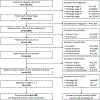Node-Positive Segmentectomy for Non-Small-Cell Lung Cancer: Risk Factors and Outcomes
- PMID: 31031205
- PMCID: PMC8669738
- DOI: 10.1016/j.cllc.2019.03.006
Node-Positive Segmentectomy for Non-Small-Cell Lung Cancer: Risk Factors and Outcomes
Abstract
Background: Segmentectomy for well-selected early stage non-small-cell lung carcinoma (NSCLC) has been shown to have similar oncologic outcomes and survival to lobectomy. However, these data are based on the presumption that the disease is node negative. Few data exist regarding the risk factors for and the outcomes of patients with disease treated with segmentectomy that is found to be node positive. We sought to determine the risk factors for and outcomes of clinical stage I NSCLC patients who are treated with segmentectomy but are determined to be node positive.
Patients and methods: We queried patients with clinical stage I NSCLC ≤ 3 cm within the National Cancer Data Base between 2004 and 2014 who were treated with segmentectomy or lobectomy and found to have positive nodes. Kaplan-Meier curves with log-rank tests were used to compare overall survival (OS) between segmentectomy and lobectomy. For comparison only, segmentectomy patients with pathologically node-negative disease were identified to determine predictors of node positivity after segmentectomy via multivariable logistic regression.
Results: A total of 4556 patients with node-positive disease were identified, comprising 115 segmentectomy patients and 4441 lobectomy patients. Multivariable analysis identified increasing tumor size, squamous-cell histology, and increasing number lymph nodes sampled as significant predictors of node positivity after segmentectomy. There was no difference in OS between segmentectomy and lobectomy, with 3-year OS rates of 66.3% and 68.1%, respectively (P = .723).
Conclusion: There are discrete risk factors for discovering positive nodes after segmentectomy. Segmentectomy is associated with similar OS compared to lobectomy for clinical stage I NSCLC found to be node positive.
Keywords: Early stage; Lymph nodes; National Cancer Data Base; Surgical resection; Survival.
Copyright © 2019 Elsevier Inc. All rights reserved.
Conflict of interest statement
Disclosure
The authors have stated that they have no conflict of interest.
Figures
References
-
- Schuchert MJ, Abbas G, Awais O, et al. Anatomic segmentectomy for the solitary pulmonary nodule and early-stage lung cancer. Ann Thorac Surg 2012; 93:1780–5. - PubMed
-
- Nomori H, Mori T, Ikeda K, Yoshimoto K, Iyama K, Suzuki M. Segmentectomy for selected cT1N0M0 non–small cell lung cancer: a prospective study at a single institute. J Thorac Cardiovasc Surg 2012; 144:87–93. - PubMed
-
- Tsutani Y, Miyata Y, Nakayama H, et al. Appropriate sublobar resection choice for ground glass opacity-dominant clinical stage IA lung adenocarcinoma: wedge resection or segmentectomy. Chest 2014; 145:66–71. - PubMed
-
- Ginsberg RJ, Rubinstein LV. Randomized trial of lobectomy versus limited resection for T1 N0 non–small cell lung cancer. Lung Cancer Study Group. Ann Thorac Surg 1995; 60:615–22. - PubMed
MeSH terms
Grants and funding
LinkOut - more resources
Full Text Sources
Medical




